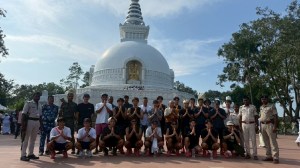An India of their Vision
Two writers, two perspectives, but for both Kipling and Rushdie, the theme is India

As writers, Rudyard Kipling and Salman Rushdie are far apart in time and style. And yet they share something in common. The underlying theme of their great novels Kim and The Moor’s Last Sigh is the same. The theme quite simply is India itself. They are superb at using magical words and phrases to bring to us with a sense of immediacy the sights, smells and tastes of this disjointed peninsula. But more importantly, they are obsessed with what one can only describe weakly as ‘a vision’, or more properly ‘visions’, of India.
Who can forget: “Kim will remember till he dies that long lazy journey from Umballa, through Kalka and the Pinjore gardens nearby up to Simla”. Rural northern India at its best! Contrast this with Rushdie’s description of Bombay. “The city itself, perhaps the whole country, was a palimpsest, Under World beneath Over World, black market beneath white”. Urban peninsular India at its worst!
Whether he acknowledged it fully or not, Kipling was a child of India and his writings are literally drenched with India. Kim can be seen as the retelling of the Krishna legend. Kim is an impish, mischievous child loved by all the adults who come across him. ‘Vaatsalya bhaava’, the emotion that a parent feels for a child can according to Indian bhakti traditions be one of the ways to approach God. This is clearly the feeling that the Lama has for Kim. The Lama is also taken in by the many disguises (incarnations?) of Kim. “As a boy in the dress of white men… a second time thou wast a Hindu… what shall the third incarnation be?” The Lama loves Kim irrespective of his appearance. “My heart went out to thee”. Mahbub Ali refers to Kim as “The Friend of All the World”, invoking the image of a transcendent divinity which certainly is attributable to Krishna. The Woman of Shamlegh calls Kim “a stealer of hearts”. ‘Chit-chor’ is a name for Krishna used frequently by his devotees who follow ‘maadhurya bhaava’, the path of romantic love which can be another chosen mode of bhakti. Kim’s association with Krishna is most complete in the episode of losing and finding his mothers. Lost to his biological mother, the Irish housemaid who gave birth to him, Kim ends the novel being “found” by his foster mother, the old lady of Sahranpur. The Devaki-Yashodha theme is played out in this moment of epiphany: “‘Maharanee,’ Kim began, but led by the look in her eye, changed it to the title of plain love — ‘Mother, I owe my life to thee’”.
Krishna is an incarnation of Vishnu. Kipling’s view of India is distinctly vaishnavite. Vishnu is the preserver of the world order. And of course, the ‘order’ that Kipling supports is the British Raj. With the help of his companions, Kim thwarts the evil plans of the Russian asuras who would destroy the peace of the Raj. From a contemporary perspective, we may not approve of the Raj. But for Kipling it is a warm secure place where the rulers and the ruled live in harmony. A land characterised by impartial justice which in Kipling’s mind was the hallmark of the dharma of the Raj. “A fair land — a most beautiful land is this of Hind”. A land where the young Kim literally holds up the hill of the Raj and helps the Creightons and the Lurgans maintain peace (shanti) and order (rta).
Salman Rushdie’s view of India as portrayed in The Moor’s Last Sigh has a distinct Shakta tone to it. The scholar Sudhir Kakar has written: “The figure of the mother is indeed omnipresent in the psyche of Indian men… she is both nurturing benefactress and threatening seductress”. The art critic Richard Blurton has noted that the very land and the soil of India are seen as physical attributes of the Mother Goddess. Rushdie falls back on these recurring themes in our collective unconscious. Rushdie’s words are brilliantly evocative. “Mother India who loved and betrayed and ate and destroyed and again loved her children and with whom the children’s passionate conjoining and eternal quarrel stretched beyond the grave; who stretched into great mountains like exclamations of the soul and along vast rivers full of mercy and disease, and across harsh drought-ridden plateaux on which men hacked with pickaxes at the dry infertile soil; Mother India with her oceans and coco-palms and rice-fields and bullocks at the water-well, her cranes on treetops with necks like coat-hangers, and high circling kites and the mimicry of mynahs and the yellow-beaked brutality of crows, a protean Mother India”. “Motherness — excuse me if I underline the point — is a big idea in India, maybe our biggest: the land as mother, the mother as land… I’m talking major mother country”.
As the novel slowly unfolds, the India of today (or is he imagining the India of tomorrow?) takes on a dark sinister tinge. It is a country of liars, murderers, smugglers and sexual excesses. Is Rushdie hinting that we are being taken over by the forbidden left-handed practices (‘vaamachaara’) of the Shakta cult? The wealthy and the rulers, instead of upholding peace and dharma, are actively violating the same. One might surmise that such continued violation of dharma may bring down the wrath of Mother India on all of us. There is an element of asuric arrogance in Aurora’s character. “Once a year, my mother Aurora Zogoiby liked to dance higher than the gods”. And we know how such conceit is punished!
The great Kannada writer Maasti has referred to India or Bharatavarsha as “Bahuratna Vasundhara” — earth studded with many gems. One can argue that Kipling’s vaishnavite point of view and Rushdie’s Shakta perspective are both equally valid gems representing facets of India which while seemingly antagonistic do, in fact, in some mysterious way reinforce each other.
Irrespective of passing
political fancies, these two books will remain classics as they describe authentic ‘visions’ of India. The writer is chairman, Mphasis
Photos





- 01
- 02
- 03
- 04
- 05

























